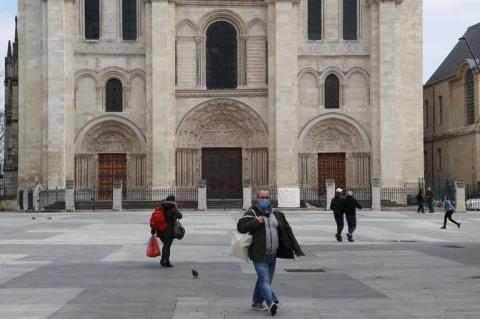Online translation of an articel in Le Figaro.
IN PICTURES - The Health Department says "no immediate explanation".
For the first time since the start of the covid-19 epidemic, the authorities published on Friday 3 April figures showing an "exceptional excess of mortality" in Seine-Saint-Denis, the poorest territory of the metropolis where the undertakers are "overwhelmed".
What do the figures say?
Several French departments heavily affected by the pandemic have recorded a sharp rise in mortality, according to provisional figures from INSEE. But in Seine-Saint-Denis, it's an explosion: between 21 and 27 March, deaths jumped by 63% compared to the previous week. An "exceptional" level, underlined Thursday evening by the Director General of Health Jérôme Salomon. For comparison, the rise reached 32% in Paris and 47% in the neighbouring department of Val-Oise.
Asked by AFP, the health department says it "has no immediate explanation" for these figures, which are all the more surprising given that the number of deaths in hospital is lower in Seine-Saint-Denis than in other parts of the Paris region. A hiatus that cannot be explained by the transfer of patients to other hospitals. Funeral directors contacted by AFP mention "numerous cases of deaths at home and in retirement homes".
How can this "excess mortality" be explained?
"In Seine-Saint-Denis, there are more deaths because there are more contaminated people, quite simply," says Frédéric Adnet, head of the Samu 93. In the department of 1.6 million inhabitants, "the virus circulates much more easily than elsewhere," he adds. "Containment is complex in disadvantaged areas like ours, where there are many large families in small homes, migrant workers' hostels and shantytowns," explains the emergency doctor. "We know that infectious diseases hit the most vulnerable hardest because they are easier to transmit and harder to monitor," he says.
The doctors at "Place santé", a community health centre in the heart of the Cité des Francs-Moisins in Saint-Denis, have found the same thing. "The impression we have is that the epidemic will be exacerbated in working-class neighbourhoods where health inequalities already exist," says the centre's coordinator, Gwenaëlle Ferré, who counts "several outbreaks with several cases" of coronavirus. She also observes that, in the neighbourhoods, many inhabitants must continue to go to work, because of their profession or their precarious status. "In our patient, there are a lot of nurses' aides, home helpers and Ehpad workers," who will be "very exposed," the coordinator explains. Not to mention "the cashiers, the delivery people".
Could a breach of containment be to blame?
A hypothesis swept away by the Ile-de-France LRA: "The people who went into intensive care this week are people who contracted the disease before being confined," explains the Regional Health Agency, tired of the controversy. In the department, the rules of confinement are, "as elsewhere, generally well respected," the prefect of 93, Georges-François Leclerc, also made a point of emphasising this week, welcoming the "spirit of responsibility" of the inhabitants.
Are certain vulnerable populations deprived of access to health care?
The PS president of the Departmental Council, Stéphane Troussel, points the finger at "a weaker health system that weighs on access to care" and the fact that there are "fewer doctors and fewer intensive care beds" in 93.
But for the Samu chief, Frédéric Adnet, the explanation for the excess mortality is not there. According to him, the inhabitants of Seine-Saint-Denis, even the most precarious, do not hesitate to call for help and "are treated as elsewhere" in France. "Everyone calls on 15, as soon as people have trouble breathing they call. For vital illnesses, people go to hospital," he says.
